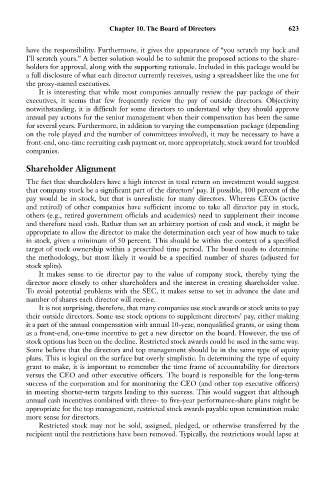Page 638 - Bruce Ellig - The Complete Guide to Executive Compensation (2007)
P. 638
Chapter 10. The Board of Directors 623
have the responsibility. Furthermore, it gives the appearance of “you scratch my back and
I’ll scratch yours.” A better solution would be to submit the proposed actions to the share-
holders for approval, along with the supporting rationale. Included in this package would be
a full disclosure of what each director currently receives, using a spreadsheet like the one for
the proxy-named executives.
It is interesting that while most companies annually review the pay package of their
executives, it seems that few frequently review the pay of outside directors. Objectivity
notwithstanding, it is difficult for some directors to understand why they should approve
annual pay actions for the senior management when their compensation has been the same
for several years. Furthermore, in addition to varying the compensation package (depending
on the role played and the number of committees involved), it may be necessary to have a
front-end, one-time recruiting cash payment or, more appropriately, stock award for troubled
companies.
Shareholder Alignment
The fact that shareholders have a high interest in total return on investment would suggest
that company stock be a significant part of the directors’ pay. If possible, 100 percent of the
pay would be in stock, but that is unrealistic for many directors. Whereas CEOs (active
and retired) of other companies have sufficient income to take all director pay in stock,
others (e.g., retired government officials and academics) need to supplement their income
and therefore need cash. Rather than set an arbitrary portion of cash and stock, it might be
appropriate to allow the director to make the determination each year of how much to take
in stock, given a minimum of 50 percent. This should be within the context of a specified
target of stock ownership within a prescribed time period. The board needs to determine
the methodology, but most likely it would be a specified number of shares (adjusted for
stock splits).
It makes sense to tie director pay to the value of company stock, thereby tying the
director more closely to other shareholders and the interest in creating shareholder value.
To avoid potential problems with the SEC, it makes sense to set in advance the date and
number of shares each director will receive.
It is not surprising, therefore, that many companies use stock awards or stock units to pay
their outside directors. Some use stock options to supplement directors’ pay, either making
it a part of the annual compensation with annual 10-year, nonqualified grants, or using them
as a front-end, one-time incentive to get a new director on the board. However, the use of
stock options has been on the decline. Restricted stock awards could be used in the same way.
Some believe that the directors and top management should be in the same type of equity
plans. This is logical on the surface but overly simplistic. In determining the type of equity
grant to make, it is important to remember the time frame of accountability for directors
versus the CEO and other executive officers. The board is responsible for the long-term
success of the corporation and for monitoring the CEO (and other top executive officers)
in meeting shorter-term targets leading to this success. This would suggest that although
annual cash incentives combined with three- to five-year performance-share plans might be
appropriate for the top management, restricted stock awards payable upon termination make
more sense for directors.
Restricted stock may not be sold, assigned, pledged, or otherwise transferred by the
recipient until the restrictions have been removed. Typically, the restrictions would lapse at

